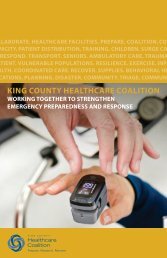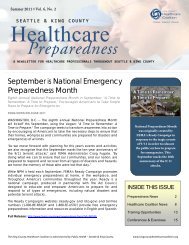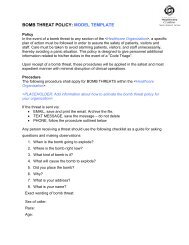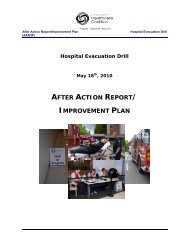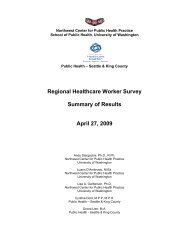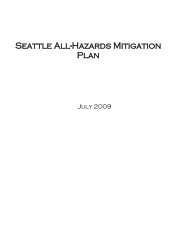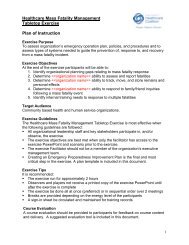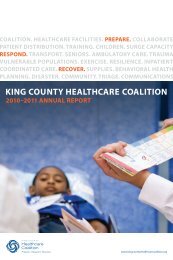After action report tabletop exercise
After action report tabletop exercise
After action report tabletop exercise
Create successful ePaper yourself
Turn your PDF publications into a flip-book with our unique Google optimized e-Paper software.
<strong>After</strong> Action Report<br />
Tabletop Exercise:<br />
Long Term Care Mutual Aid Plan (LTC-MAP)<br />
for Evacuation & Resources / Assets<br />
Scott Aronson<br />
Russell Phillips & Associates, LLC<br />
31 Cooke Street<br />
Plainville, CT 06062<br />
T: 860-793-8600<br />
www.phillipsllc.com<br />
March 4, 2010<br />
A service of the King County Healthcare Coalition and<br />
Public Health Seattle & King County<br />
www.mutualaidplan.org/kingcountywa
<strong>After</strong> Action Report/Improvement Plan King County Healthcare Coalition<br />
(AAR/IP) LTC-MAP Evacuation and Resources / Assets Plan<br />
ADMINISTRATIVE HANDLING INSTRUCTIONS<br />
1. The title of this document is the King County Long Term Care Mutual Aid Plan<br />
(LTC-MAP) for Evacuation & Resources / Assets.<br />
2. The information gathered in this AAR/IP is classified as For Official Use Only and<br />
should be handled as sensitive information not to be disclosed. This document<br />
should be safeguarded, handled, transmitted, and stored in accordance with<br />
appropriate security directives. Reproduction of this document, in whole or in<br />
part, without prior approval from King County Healthcare Coalition is prohibited.<br />
3. At a minimum, the attached materials will be disseminated only on a need-toknow<br />
basis and when unattended, will be stored in a locked container or area<br />
offering sufficient protection against theft, compromise, inadvertent access, and<br />
unauthorized disclosure.<br />
4. Point of Contact:<br />
Lydia Ortega<br />
Healthcare Coalition Administrator/Business Manager<br />
PUBLIC HEALTH │ SEATTLE & KING COUNTY<br />
401 5th Ave., Ste. 1300, Seattle, WA 98104<br />
206.263.8721 p │ 206.296.0166 f<br />
lydia.ortega@kingcounty.gov<br />
Danica Mann<br />
Training and Exercise Manager<br />
King County Healthcare Coalition<br />
206.947.5565<br />
Danica.mann@overlakehospital.org<br />
Administrative Handling Instructions 2 King County Healthcare Coalition
<strong>After</strong> Action Report/Improvement Plan King County Healthcare Coalition<br />
(AAR/IP) LTC-MAP Evacuation and Resources / Assets Plan<br />
Contents<br />
Administrative Handling Instructions ..................................................... 2<br />
Contents..................................................................................................... 3<br />
Executive Summary .................................................................................. 4<br />
Section 1: Exercise Overview .................................................................. 6<br />
Exercise Details.......................................................................................................... 6<br />
Exercise Planning Team & Planning Meetings .......................................................... 7<br />
Participating Organizations ........................................................................................ 7<br />
Section 2: Exercise Design Summary..................................................... 8<br />
Exercise Purpose and Design .................................................................................... 8<br />
Objectives, Capabilities & Activities ........................................................................... 9<br />
Scenario Summary..................................................................................................... 9<br />
Exercise Format ....................................................................................................... 11<br />
Section 3: Analysis & Performance Improvement ............................... 12<br />
Section 4: Conclusion............................................................................. 22<br />
Contents 3 King County Healthcare Coalition
<strong>After</strong> Action Report/Improvement Plan King County Healthcare Coalition<br />
(AAR/IP) LTC-MAP Evacuation and Resources / Assets Plan<br />
Executive Summary<br />
Although rare, evacuation of a healthcare facility is a complex event requiring significant<br />
coordination throughout the local community and the extended region. An evacuation of<br />
this extent necessitates both internal and external planning. The success of an<br />
evacuation is dependent on the effectiveness of internal procedures, external<br />
relationships and cooperation/coordination with other healthcare facilities and<br />
community emergency responders. A unified and coordinated response is essential.<br />
This <strong>tabletop</strong> <strong>exercise</strong> activated the internal nursing home evacuation procedures,<br />
initiated inter<strong>action</strong> with the Public Health Duty Officer and the Health & Medical Area<br />
Command (HMAC), activated the King County Long Term Care Mutual Aid Plan and<br />
tested the surge capacity / Influx of Patients process for the receiving healthcare<br />
facilities.<br />
This <strong>After</strong> Action Report (AAR) is designed to analyze <strong>exercise</strong> results, identify<br />
strengths to be maintained and built upon, identify potential areas for further<br />
improvement, and support the development of corrective <strong>action</strong>s.<br />
Major Strengths<br />
The major strengths identified during this <strong>exercise</strong> are as follows:<br />
� Activation: The plan was generally activated following the activation protocol<br />
in the Long Term Care Mutual Aid Plan (LTC-MAP).<br />
� Coordination: Each Disaster Struck Facility was prepared with their internal<br />
steps for the evacuation plan, evacuation sites and a current Transportation<br />
Evacuation Survey prepared for EMS / Fire.<br />
� Communication: The communication between the Disaster Struck Facility<br />
and Patient Accepting Facilities plus the Health & Medical Area Command<br />
and the Disaster Struck Facility was well established.<br />
� Influx / Surge: Receiving facilities provided a sound foundation for their<br />
<strong>action</strong>s and thought process to prepare for a patient influx / surge.<br />
� Tracking: Patient tracking was successful. Participants utilized tracking<br />
forms and communication channels to relay patient information. The goal<br />
was to understand where the patients were sent compared against the master<br />
list of patients, and this process was included.<br />
Primary Areas for Improvement<br />
Several opportunities exist for improvement in the King County’s ability to conduct an<br />
evacuation. The primary areas for improvement are as follows (see Analysis of<br />
Exercise for detailed recommendations):<br />
� Communications: Clearly delineated communications on responsibilities need<br />
to be established early between the HMAC and the Disaster Struck Facility as<br />
Executive Summary 4 King County Healthcare Coalition
<strong>After</strong> Action Report/Improvement Plan King County Healthcare Coalition<br />
(AAR/IP) LTC-MAP Evacuation and Resources / Assets Plan<br />
to what resource each requires and who they will be communicating with.<br />
This coordinating of roles and responsibilities between the Disaster Struck<br />
Facility and coordinating support group (EOC / HMAC / etc.) were discussed<br />
but could pose a substantial challenge to concise communications with the<br />
Patient Accepting Facilities if not formally pre-established (i.e. HMAC will deal<br />
with all Patient Accepting Facilities and the Disaster Struck Facility will deal<br />
with management of the incident and communications with EMS / Fire onscene.)<br />
� Documentation: The LTC-MAP plan provides extensive information and<br />
multiple forms. While forms were discussed in general terms, there is a<br />
learning curve to using the forms and the database to retrieve information.<br />
� Patient Tracking: Clearly and accurately documenting on the appropriate<br />
tracking forms and ensuring all forms end up in the appropriate location –<br />
Disaster Struck Facility Command Center, Patient Accepting Facility or<br />
HMAC.<br />
� Education: Education of leadership and staff at the facilities on use of the<br />
LTC-MAP, the forms and how to handle an incoming call from a Disaster<br />
Struck Facility or HMAC.<br />
As appropriate, staff should continue to be educated on the:<br />
o Resident Evacuation Tracking Forms<br />
o Patient/Medical Record and Equipment Tracking Sheet<br />
o Incoming Patient Log<br />
o Disaster Struck Facility and HMAC Aggregate Tracking Forms<br />
o Utilization of the LTC-MAP database to retrieve information<br />
o Role of the HMAC<br />
o Internal activation/notification procedures<br />
Executive Summary 5 King County Healthcare Coalition
<strong>After</strong> Action Report/Improvement Plan King County Healthcare Coalition<br />
(AAR/IP) LTC-MAP Evacuation and Resources / Assets Plan<br />
Exercise Details<br />
SECTION 1: EXERCISE OVERVIEW<br />
Exercise Name<br />
King County Long Term Care Mutual Aid Plan (LTC-MAP) for Healthcare<br />
Evacuation and Medical Surge<br />
Type of Exercise<br />
Tabletop<br />
Exercise Start Date<br />
4 March 2010<br />
Exercise End Date<br />
4 March 2010<br />
Duration<br />
Approximately 2 hours with 3 additional hours of education incorporated<br />
Location<br />
Tukwila Community Center, Tukwila, WA 98168<br />
Sponsor<br />
King County Healthcare Coalition<br />
Program<br />
Regional Catastrophic Grant Program<br />
Mission<br />
Response<br />
Capabilities<br />
Medical Surge (Disaster Struck Facility / Patient Accepting Facilities /<br />
Communications<br />
Scenario Type<br />
Healthcare Evacuation<br />
Section 1: Exercise Overview 6 King County Healthcare Coalition<br />
For Official Use Only
<strong>After</strong> Action Report/Improvement Plan King County Healthcare Coalition<br />
(AAR/IP) LTC-MAP Evacuation and Resources / Assets Plan<br />
Exercise Planning Team<br />
Henk Straatman<br />
Life Care Center of West Seattle<br />
Seattle, WA<br />
Mark Weise<br />
Providence Mount St. Vincent<br />
Seattle, WA<br />
Lydia Ortega<br />
Public Health Seattle & King County<br />
Seattle, WA<br />
Danica Mann<br />
King County Healthcare Coalition<br />
Seattle, WA<br />
Long Term Care Mutual Aid Plan Task Force / Special Expertise Committees<br />
Scott Aronson<br />
Russell Phillips & Associates, LLC<br />
Plainville, CT<br />
Planning Meetings<br />
October 28, 2009 – Initial Planning Conference (Task Force Meeting)<br />
December 15, 2009 – Intermediate Planning Conference (Public Health)<br />
February 26, 2010– Final Planning Conference (Disaster Struck Facilities)<br />
Participating Organizations<br />
� Public Health Seattle & King County<br />
� King County Healthcare Coalition<br />
� Seattle Fire<br />
� King County Metro<br />
� Life Care Center of West Seattle (Disaster Struck Facility)<br />
� Providence Mount Saint Vincent (Disaster Struck Facility)<br />
� Multiple representatives from Patient Accepting Facilities<br />
Number of Participants<br />
• Controllers: 1<br />
• Evaluators: 4<br />
• Players: 30<br />
Section 1: Exercise Overview 7 King County Healthcare Coalition<br />
For Official Use Only
<strong>After</strong> Action Report/Improvement Plan King County Healthcare Coalition<br />
(AAR/IP) LTC-MAP Evacuation and Resources / Assets Plan<br />
SECTION 2: EXERCISE DESIGN SUMMARY<br />
Exercise Purpose and Design<br />
The emphasis of this <strong>exercise</strong> was to implement the King County Long Term Care<br />
Mutual Aid Plan (LTC-MAP) for Evacuation and Resources / Assets via the evacuation<br />
of multiple healthcare facilities. Additionally, the <strong>exercise</strong> was designed to introduce the<br />
plan to all of the regional long term care facilities, emergency management directors,<br />
EMS, Fire, State and other regional groups that may not have been exposed to the<br />
LTC-MAP during the design phase while providing practice on implementing the plan<br />
and an opportunity to improve that plan during the Tabletop Exercise.<br />
The focus was on properly coordinating the activation of the plan, set-up of the internal<br />
full building evacuation plans, coordination of regional communication via the Health &<br />
Medical Area Command (HMAC), tracking patients and supporting the surge capacity<br />
plans at each of the patient accepting facilities.<br />
This <strong>exercise</strong> was initiated with the decision to evacuate a single facility and concluded<br />
with the confirmation of patients being received at the Patient Accepting Facilities.<br />
This <strong>exercise</strong> involved the following tables:<br />
� Health & Medical Area Command / Long Term Care Coordinating Team (1 table)<br />
� Disaster Struck Facilities (1 table)<br />
� Patient Accepting Facilities and Transportation (2 tables)<br />
Please note that the artificialities with time during the <strong>exercise</strong> were designed to<br />
eliminate primary discussions about all of the steps that would be taken to avoid the<br />
need to evacuate and focus on the evacuating taking place. Discussions did take place<br />
at the Disaster Struck Facilities about steps they would be completing concurrently to<br />
re-establish their facilities to re-open and accept patients.<br />
Section 2: Exercise Design Summary 8 King County Healthcare Coalition
<strong>After</strong> Action Report/Improvement Plan King County Healthcare Coalition<br />
(AAR/IP) LTC-MAP Evacuation and Resources / Assets Plan<br />
Objectives, Capabilities, and Activities<br />
There were several objectives for this <strong>exercise</strong>:<br />
Overarching Objectives<br />
1. Activation: Upon the start of the <strong>exercise</strong>, utilize the activation/notification<br />
procedures within the King County LTC-MAP.<br />
2. Communication: Communicate appropriately between the Disaster Struck Facility,<br />
Health & Medical Area Command (HMAC), Local Emergency Responders,<br />
Department of Social and Health Services (DSHS), and Patient Accepting Facility.<br />
3. Tracking: Ensure that patients are tracked throughout the entire process, from the<br />
Disaster Struck Facility to the Patient Accepting Facility.<br />
4. Medical Surge: Provide from the Disaster Struck Facility (DSF) consistent, accurate<br />
and relevant health and medical information to clinicians and other responders about<br />
patients being evacuated in an organized and timely manor and internal facility<br />
surge process.<br />
Disaster Struck Facilities (Facilities being evacuated)<br />
1. Communication: Ensure the facility being evacuated communicates appropriately<br />
to contact local 911/emergency responders, Public Health Duty Officer, HMAC and<br />
Patient Accepting Facilities.<br />
2. Tracking: Use LTC-MAP tools, communication channels and documentation to<br />
ensure that patients are tracked to each Patient Accepting Facility.<br />
Health & Medical Area Command (HMAC) / Long Term Care Coordinating Team<br />
1. Communication: Ensure appropriate communication with the Disaster Struck<br />
Facility and have communication channels established with local EOCs as<br />
necessary and Patient Accepting Facilities.<br />
2. Planning: The HMAC will utilize administrative tools within the King County LTC-<br />
MAP to support the evacuation and patient placement / tracking.<br />
Patient Accepting Facilities<br />
1. Communication: Ensure the Patient Accepting Facility communicates appropriately<br />
to maintain contact with the HMAC and/or Disaster Struck Facility.<br />
2. Tracking: Use King County LTC-MAP communication channels and documentation<br />
to ensure that patients are accounted for at the Patient Accepting Facility and patient<br />
status is <strong>report</strong>ed to the HMAC or the Disaster Struck Facility.<br />
3. Medical Surge: Ensure that internal plans are implemented and documented for<br />
Influx of Patients / Surge Capacity Plans.<br />
Section 2: Exercise Design Summary 9 King County Healthcare Coalition
<strong>After</strong> Action Report/Improvement Plan King County Healthcare Coalition<br />
(AAR/IP) LTC-MAP Evacuation and Resources / Assets Plan<br />
Scenario Summary<br />
Situation / Status Report 1: 3/4/2010 at 1:00 PM<br />
Due to a severe weather emergency, Life Care Center of West Seattle has lost their<br />
HVAC capabilities. The facility is being forced to evacuate with the support of Seattle<br />
Fire and private EMS companies. The decision has been made to activate the Long<br />
Term Care Mutual Aid Plan to support resource coordination and establishing Patient<br />
Accepting Facilities. The facility had a current census of 83 patients with 11 requiring<br />
EMS transport (BLS Ambulance), 49 needing wheelchair accessible vehicles and 23<br />
that could go by any means of transport.<br />
Situation / Status Report 2: 3/4/2010 at 1:45 PM<br />
While the initial evacuation is going smoothly and the facility, along with EMS, have preselected<br />
the healthcare facilities where all of the patients will be placed, another<br />
situation has arisen. Providence Mount St. Vincent has experiences sprinkler pipes<br />
bursting on the top 2 floors causing extensive internal damage. They are moving to<br />
immediately relocate patients to other buildings on campus as Stop Over Points and are<br />
requesting support to evacuate higher acuity patients first, followed by temporary<br />
locations to place their other nursing home patients. The facility had a current census of<br />
210 patients with 7 requiring EMS transport (BLS Ambulance), 159 needing wheelchair<br />
accessible vehicles and 44 that could go by any means of transport. Additionally, on<br />
campus they had another 109 residents in Assisted Living (14 requiring wheelchair<br />
accessible vehicle and 95 that could go by any means of transport) and 14 Adult Day<br />
Health Care residents (7 requiring a wheelchair accessible vehicle and 7 that could go<br />
by any means of transport.) Overall, there was the potential that 333 total<br />
patients/residents may have to be fully evacuated.<br />
The situation is forcing the Health & Medical Area Command, along with Seattle Fire, to<br />
re-evaluate where the patients could be moved to and ensure that each evacuating<br />
facility coordinates centrally through the group.<br />
Situation / Status Report 3: 3/4/2010 at 2:30 PM<br />
Each facility has been receiving incoming patients/residents from the evacuating<br />
healthcare facilities and <strong>report</strong>ing this information back to either the Disaster Struck<br />
Facility or the Health & Medical Area Command (depending on which group they were<br />
told to contact). While the evacuations will take several more hours to complete, the<br />
pre-designation of evacuating sites has been completed and the HMAC is able to<br />
coordinate effectively by utilizing the LTC Coordinating Team.<br />
Section 2: Exercise Design Summary 10 King County Healthcare Coalition
<strong>After</strong> Action Report/Improvement Plan King County Healthcare Coalition<br />
(AAR/IP) LTC-MAP Evacuation and Resources / Assets Plan<br />
Exercise Format<br />
This was a Tabletop Exercise. The <strong>exercise</strong> began with a scenario for all participants.<br />
Roles and Responsibilities<br />
• Players respond to the situation presented based on their experience and the new<br />
Long Term Care Mutual Aid Plan (LTC-MAP) for Evacuation and Resources /<br />
Assets.<br />
• The Controller provided situation updates and moderated discussions. The<br />
Controller also provided additional information or resolved questions as required.<br />
• Evaluators did not participate in the discussion, but were present for the duration of<br />
the <strong>exercise</strong> gathering data and writing notes about the players’ responses in order<br />
to provide feedback for the <strong>exercise</strong> <strong>After</strong> Action Report (AAR).<br />
• A Hotwash was conducted for 30 minutes at the conclusion of the <strong>exercise</strong>.<br />
Assumptions and Artificialities<br />
In any <strong>exercise</strong>, a number of assumptions and artificialities may be necessary to<br />
complete play in the time allotted. During the <strong>exercise</strong>, the following apply:<br />
• The scenario is plausible, and events occur as they are presented.<br />
• There are no “hidden agendas” or trick questions.<br />
• All players receive information at the same time.<br />
• The simulation of time passing may be accelerated or delayed as appropriate by the<br />
<strong>exercise</strong> controller.<br />
Assumptions<br />
• Players are familiar with LTC-MAP following their education on the plan.<br />
• Exercise players include senior leadership from the King County Healthcare<br />
Coalition and the LTC-MAP Task Force, who are empowered to create a new or<br />
modify any existing plans and policies, if necessary.<br />
Section 2: Exercise Design Summary 11 King County Healthcare Coalition
<strong>After</strong> Action Report/Improvement Plan King County Healthcare Coalition<br />
(AAR/IP) LTC-MAP Evacuation and Resources / Assets Plan<br />
SECTION 3: ANALYSIS AND PERFORMANCE IMPROVEMENT<br />
This section of the <strong>report</strong> reviews the performance of the <strong>exercise</strong>d capabilities,<br />
activities, and tasks. Each activity is followed by related observations, which include<br />
references, analysis, and recommendations. As any plan member could be the<br />
Disaster Struck or Patient Accepting Facility during a real activation, these observations<br />
are relevant to all plan members.<br />
HMAC = Health & Medical Area Command<br />
EOC = Emergency Operations Center<br />
I. Internal Healthcare Facility Command Center (Disaster Struck<br />
Facility):<br />
1. Observation – Incident Command System improvements: The application of<br />
Incident Command System needs to be reviewed and enhanced at long term<br />
care facilities. It has been identified that staff need continuous education on what<br />
the Incident Command System is and how the positions and communications will<br />
work internally and externally. This would include having a formal Incident<br />
Commander and Command Staff position (Liaison, Safety / Security, Public<br />
Information Officer) and Section Chiefs (Operations, Logistics, Planning, Finance<br />
/ Administration).<br />
Recommendation: All facilities should incorporate incident command into their<br />
plans. This includes having a Table of Organization and Job Action Sheets to<br />
use as a checklist during a disaster. Further <strong>exercise</strong>s and training for facilities in<br />
Incident Command is needed.<br />
A number of incident command trainings can be found on-line through FEMA. A<br />
few samples of the programs are listed below:<br />
� The links below lead to ICS courses for Healthcare. This site is run by FEMA,<br />
and each course should take approximately 2-4 hours, plus a post-test. They<br />
are offered at no cost, and certificates of completion will be provided.<br />
� Introduction to ICS:<br />
http://training.fema.gov/EMIWeb/IS/is100HC.asp<br />
� National Incident Management System<br />
http://training.fema.gov/EMIWeb/IS/is700a.asp<br />
� Applying ICS to Healthcare:<br />
http://training.fema.gov/EMIWeb/IS/is200HCa.asp<br />
� Additionally, there is free training through Yale that is healthcare specific.<br />
These programs are EM108 (equivalent to FEMA 700 level course for<br />
Section 4: Conclusion 12 King County Healthcare Coalition
<strong>After</strong> Action Report/Improvement Plan King County Healthcare Coalition<br />
(AAR/IP) LTC-MAP Evacuation and Resources / Assets Plan<br />
introduction to the National Incident Management System) and EM142<br />
(equivalent to ICS 100 and 200):<br />
� http://ynhhs.emergencyeducation.org/<br />
2. Observation – Use of the LTC-MAP manual: The Disaster Struck Facility<br />
should become familiar with the flow of the LTC-MAP hard copy plan to ensure<br />
effective use during a disaster.<br />
Recommendation: All plan members should consider internal education on the<br />
LTC–MAP plan for Nursing Supervisors, leadership and managers so there is a<br />
baseline understanding of how to use the plan.<br />
II. Communications with (Disaster Struck Facility, HMAC, EOC,<br />
Patient Accepting Facility, Media):<br />
3. Observation – HMAC to Disaster Struck Facility: Health and Medical Area<br />
Command (HMAC) and the Disaster Struck Facility should establish early on in<br />
the incident the division of duties to avoid duplication of calls and <strong>action</strong>s.<br />
Recommendation: There should be early communications between HMAC and<br />
the Disaster Struck Facility and establish a briefing timeframe. It should be<br />
determined which organization is speaking with the Patient Accepting Facilities,<br />
families and other agencies.<br />
If HMAC manages the calls, then a regional call center may be setup.<br />
4. Observation – Disaster Struck Facility / Patient Accepting Facility and the<br />
Media: Facility specific plans should include reference to Public Information<br />
sharing. Working with the HMAC and On-scene fire/EMS will ensure that there is<br />
one message going out from all plan members to the Media.<br />
Recommendation: Long term care facilities should ensure there is a person<br />
internally designated as the Public Information Officer (PIO) to manage all<br />
messages being used internally to educate staff and externally with HMAC, the<br />
media and community partners. See LTC-MAP plan in Annex I, Section 4, #10<br />
Section 4: Conclusion 13 King County Healthcare Coalition
<strong>After</strong> Action Report/Improvement Plan King County Healthcare Coalition<br />
(AAR/IP) LTC-MAP Evacuation and Resources / Assets Plan<br />
5. Observation – HMAC to EOCs: During a large scale incident, there is a need to<br />
coordinate situational awareness information between HMAC and EOC’s about<br />
facilities that fall within their jurisdiction. This might include local EOCs<br />
assessing facilities based on criteria established by HMAC and <strong>report</strong>ing to<br />
HMAC on their status. HMAC would then aggregate the situation updates and<br />
distribute regionally to all EOC’s and healthcare partners throughout the event.<br />
Recommendation: HMAC should coordinate with local EOC’s to develop<br />
protocols on assessing healthcare facilities within their jurisdiction.<br />
III. Activation/Notification:<br />
6. Observation – Internal Facility Notification Process: The internal process for<br />
notifications within a receiving facility needs to be clearly defined so facilities are<br />
positioned to respond.<br />
Recommendation: Staff members should be educated what to do if a call is<br />
received from a Disaster Struck Facility or if a WATrac alert is received. It is<br />
recommended that facilities create a quick reference guide/sheet providing<br />
detailed instructions to anyone that may be in the position to receive an outside<br />
call or message, on or off-hours.<br />
7. Observation – WATrac Communications - Challenges: The LTC-MAP<br />
facilities are not yet active on WATrac and therefore the only method to stand up<br />
the plan is by phone.<br />
Recommendation: Russell Phillips & Associates will provide Public Health<br />
Seattle & King County with all data to load the information into WATrac so that<br />
facilities can be alerted through WATrac. Following the importing of<br />
information, education should take place with LTC-MAP members on use of the<br />
system.<br />
8. Observation – Disaster Struck Facility Communication to Public Health<br />
Duty Officer to Activate the Plan: It was identified that clear and concise<br />
methods need to be instituted to contact the Public Health Duty Officer to activate<br />
the plan. This needs to be accompanied by clear communication about the<br />
incident.<br />
Recommendation: When a Disaster Struck facility communicates with the<br />
Public Health Duty Officer, they should be prepared to communicate the following<br />
information:<br />
� Who – Your contact name and direct phone number during the<br />
incident<br />
� Where – Facility Name and Town/City<br />
Section 4: Conclusion 14 King County Healthcare Coalition
<strong>After</strong> Action Report/Improvement Plan King County Healthcare Coalition<br />
(AAR/IP) LTC-MAP Evacuation and Resources / Assets Plan<br />
IV. Patient Tracking:<br />
� What – Evacuating or Potential to Evacuate<br />
� When – Imminent or window of time<br />
� Why – Reason<br />
9. Observation – Education on Tracking Sheets/Disaster Tags: Players were<br />
not always familiar with how to incorporate the use of the Resident Evacuation<br />
Tracking Forms and the Patient/Medical Records and Equipment Tracking Sheet.<br />
Additionally, an Influx of Patient Log form was provided for facilities to consider<br />
as an internal tool for receiving patients – designed to complement the existing<br />
Tracking Sheets/Tags.<br />
Recommendations:<br />
a. Provide the Resident Evacuation Tracking Form to staff members during<br />
training to help familiarize them with filling out the tags and the method for<br />
attaching them to patients.<br />
- The Healthcare Coalition should coordinate with plan members to print<br />
this form in triplicate and distribute appropriate amounts to each<br />
healthcare facility.<br />
b. Plan members should provide the Patient/Medical Records and Equipment<br />
Tracking Sheet to all nursing and leadership team members that could be in<br />
the capacity to send the patients out of the Disaster Struck Facility or receive<br />
them at the Patient Accepting Facility.<br />
- The Healthcare Coalition should coordinate with plan members to print<br />
this form in triplicate (1 stays with the Disaster Struck Facility, 1 copy with<br />
EMS and 1 copy to the Patient Accepting Facility) and distribute<br />
appropriate amounts to each healthcare facility.<br />
c. There will always be Just-In-Time training that is necessary during an<br />
emergency or disaster. Ensure core groups of staff are very familiar with the<br />
tracking components of the plan so they can help familiarize their colleagues.<br />
d. At the Patient Accepting Facility, Influx of Patients forms should have copies<br />
made, with the master copy staying with the patient and the copy going to<br />
the Command Center. If these forms are printed as duplicate or triplicate, it<br />
will solve this issue without having to make copies.<br />
e. At the Disaster Struck Facility and HMAC, the Aggregate Patient Tracking<br />
Tools should be printed on 3ft wide by 2ft high on dry erase board laminate.<br />
- Healthcare Coalition should coordinate with plan members to print this<br />
form for each healthcare facility Command Center and the EOCs / HMAC.<br />
Section 4: Conclusion 15 King County Healthcare Coalition
<strong>After</strong> Action Report/Improvement Plan King County Healthcare Coalition<br />
(AAR/IP) LTC-MAP Evacuation and Resources / Assets Plan<br />
10. Observation – Clinical Needs of the Patients for Tracking: Although this<br />
<strong>exercise</strong> did not involve simulated patient care, in a real activation, the Disaster<br />
Struck Facility would need to communicate clinical patient information to the<br />
Patient Accepting Facility, if possible.<br />
Recommendation: The Disaster Struck Facility should attempt to designate a<br />
clinical staff member (Operations Section Chief) to coordinate with the Liaison<br />
Officer and insert them as the primary point-of-contact with the HMAC/EOC<br />
and/or Patient Accepting Facility, to ensure medical information is properly<br />
communicated. Appropriate medical record and medications lists should<br />
accompany the patient.<br />
Matching the correct patient with the correct facility is important.<br />
11. Observation – Barcode Labels: A patient tracking system, such as bar-code<br />
labels, was discussed as necessary to more effectively track the patients.<br />
Recommendation: The Healthcare Coalition and Public Health Seattle & King<br />
County should consider the implementation of a patient tracking system, that<br />
might include barcode labels with tracking numbers for each patient at each<br />
facility.<br />
12. Observation – Top Ten List: Facilities did not have a detailed preplanned<br />
listing of their “top ten” locations where they would like to evacuate to in a<br />
disaster.<br />
Recommendation: Each long term care facility should review the plan members<br />
and other facilities that are not plan members, and select the appropriate<br />
facilities, based on the LTC Facility Information Report and Special Categories of<br />
Care Report, that can handle their patients’ clinical needs and total number of<br />
patients. This should be entered directly into the database under Evacuation<br />
Sites.<br />
V. Command & Control:<br />
13. Observation – Steering Committee / LTC Coordinating Team: Individuals<br />
should be selected from the overall group to operate as the Steering Committee<br />
to manage the overall plan on a quarterly basis. This group would also have<br />
members that are responders to the HMAC to be the voice of the long term care<br />
community in a disaster.<br />
Recommendation: Several individuals signed up to be members of the Steering<br />
Committee and be responders. There will need to be a team of 12 individuals<br />
Section 4: Conclusion 16 King County Healthcare Coalition
<strong>After</strong> Action Report/Improvement Plan King County Healthcare Coalition<br />
(AAR/IP) LTC-MAP Evacuation and Resources / Assets Plan<br />
comprised with an even balance of Administrators, Nursing and Support<br />
Services. This team will require additional Incident Command System training on<br />
how to interact with the HMAC and EOCs as well as having Job Action Sheets,<br />
forms and tools to coordinate the LTC-MAP. Public Health Seattle and King<br />
County has contracted Russell Phillips & Associates to develop this process and<br />
create tools for HMAC and for responders.<br />
14. Observation – Decision-making on Patient Destinations: In a single facility<br />
incident, the facility will be working directly with the Patient Accepting Facilities to<br />
place patients and will utilize support from the Health & Medical Area Command<br />
(HMAC), Fire/EMS and local EOCs as necessary. There was confusion in a<br />
multiple facility incident as to how decisions on placement will take place.<br />
Recommendation: In a multiple facility incident, the Disaster Struck Facilities<br />
will still be organizing and making initial planning decisions on where their<br />
patients will be transferred. The difference in how the incident will operate is that<br />
the information will flow up to the HMAC and verifications will be made about if<br />
those facilities are designated for other incoming patients or if they are impacted<br />
by the disaster and are no longer able to accept patients. HMAC is providing<br />
coordinating support along with the Long Term Care Coordinating Team<br />
(responders) to ensure that the Disaster Struck Facility is aware of the regional<br />
impact due to the emergency. Russell Phillips & Associates has been contracted<br />
with to operationalize this process.<br />
15. Observation – Incident Action Plan: Individual members of the EOC teams<br />
needed additional prompting in how to prepare an Incident Action Plan and some<br />
additional focus areas in supporting a regional disaster.<br />
Recommendation: In developing an Incident Action Plan, staff should consider<br />
addressing the following:<br />
• Developing an Incident Action Plan<br />
o What do we need to do?<br />
o Who is doing it?<br />
o What is necessary to stabilize the Incident?<br />
o How do we communicate (to DSF, to emergency responders, to<br />
DPH, to PAFs)?<br />
• SALT (words to live by in coordinating an evacuation)<br />
o Size (# of patients) of the Disaster Struck Facility(ies)?<br />
o Amount of Resources Necessary to Evacuate the Facility (types of<br />
transportation required, unique patient requirements)?<br />
o Location of Pick-up for Patients?<br />
o Time to get them out (how fast are they evacuating)?<br />
Section 4: Conclusion 17 King County Healthcare Coalition
<strong>After</strong> Action Report/Improvement Plan King County Healthcare Coalition<br />
(AAR/IP) LTC-MAP Evacuation and Resources / Assets Plan<br />
VI. General:<br />
16. Observation – Patient Accepting Facility Actions: We would like to<br />
complement the Patient Accepting Facilities that were able to fully discuss their<br />
Influx of Patients plan as they reviewed the process upon entry to their facility.<br />
Recommendation: Please continue to share your experiences in fully activating<br />
with all members of the LTC-MAP plan as facilities continue to improve their<br />
internal plans. One improvement will be that Russell Phillips & Associates will be<br />
providing a best practices guidelines on how to surge. This will be made<br />
available the summer 2010.<br />
� Sample of how another out-of-state facility surged:<br />
o Received and communicated to all staff quickly and all staff on alert<br />
o Education information posted on daily board for staff to review<br />
o Set-up beverages/food station, pillows/blankets/fans, puzzle books<br />
for entertainment<br />
o Appropriate medical supplies, tools for assessment of<br />
temperature/pulse/respiration and privacy curtains put in place<br />
o Supportive devices – wheelchairs/walkers/canes, close proximity to<br />
the restrooms, services to support patients<br />
o Pastoral Care / Psych – Emotional support in place<br />
o Communications – Phones for incoming patients to speak with<br />
families<br />
o Buddy system established for incoming patients for support<br />
o Charts started with paperwork for care plans, mini mentors /<br />
associates<br />
o Chapel converted into triage – area with medical supplies,<br />
equipment and comfort measures<br />
o Executive Director spoke directly with the Mayors Office for<br />
Emergency Preparedness to review the overall experience.<br />
o Recommendation: Other than perishable, have all of the supplies<br />
necessary to receive your appropriate number of patients in a<br />
supply closet or other location – clean, stacked and ready to go.<br />
Overall a wonderful learning experience and the ED was able to<br />
learn first hand about the dedication and caring of her staff for<br />
people in need.<br />
17. Observation – Surge Capacity: It was identified in several organizations that<br />
several issues pose a challenge in expanding to 110% of licensed beds:<br />
� Multiple facilities referenced concerns with getting enough equipment to<br />
support a surge (beds being the primary)<br />
� Concern was raised about needing a Waiver from DSHS to surge<br />
Recommendation: All are good comments. Long term care facilities typically<br />
are not involved in surge capacity and therefore do not have processes to<br />
Section 4: Conclusion 18 King County Healthcare Coalition
<strong>After</strong> Action Report/Improvement Plan King County Healthcare Coalition<br />
(AAR/IP) LTC-MAP Evacuation and Resources / Assets Plan<br />
accomplish a surge.<br />
For the equipment, it is important to note what you specifically need to be able to<br />
surge to the number requested of you. Work as a group to understand the<br />
resources each facility has and what can be provided by HMAC or your local<br />
emergency management agency.<br />
Finally, for the waiver, an approach is being presented to DSHS based on what<br />
some other states are doing. DSHS has reviewed the plan and provided support<br />
for the plan, which included the surge approach to 110% of licensed beds. If<br />
approved, documentation will be provided to update the plan.<br />
18. Observation – Healthcare Facility-owned Transportation Assets: With the<br />
healthcare facilities having a high volume transportation capability to assist the<br />
Disaster Struck Facility(ies), it was determined that there may be coordinating<br />
challenges around transportation and clarification needed on what information<br />
should be provided to the Disaster Struck Facility / HMAC / Emergency<br />
Responders.<br />
Recommendation: The facility-owned vehicles should be utilized in the<br />
following ways once the plan is activated:<br />
� Patient Accepting Facilities should be prepared to provide a status update<br />
on available vehicles in the following manner:<br />
o Time when the vehicles will be available and for how long.<br />
o Type of vehicles that will be available in that window of time.<br />
o Determination as to whether or not your facility will be able to pick<br />
up the patients that are coming to your facility and provide a clinical<br />
team member to support the transfer.<br />
� If picking up, Patient Accepting Facilities will need be provided with the<br />
location of the staging area where you will pick-up patients<br />
� When the incident is over, the vehicles should be used to help Disaster<br />
Struck Facility get their patients, staff and equipment back to their facility<br />
19. Observation – Offering Additional Beds to EOC or Disaster Struck Facility:<br />
One facility posed the question “At what point can we offer additional beds?”<br />
Recommendation: There are 2 times that a facility should offer additional beds:<br />
� When the facility is formally being notified that it will be receiving patients.<br />
� If, early on in the incident, your facility can handle a significant amount of<br />
additional beds (not 2 or 3 more, that would take place at the 1 st bullet, but<br />
8 – 10 or so), this should take place by calling the Disaster Struck Facility<br />
(or HMAC if it is operational) once it is verified that the facility is<br />
evacuating.<br />
Section 4: Conclusion 19 King County Healthcare Coalition
<strong>After</strong> Action Report/Improvement Plan King County Healthcare Coalition<br />
(AAR/IP) LTC-MAP Evacuation and Resources / Assets Plan<br />
20. Observation – Exercises: Several members expressed interest in running an<br />
<strong>exercise</strong> with the physical movement of Mock Patients to other healthcare<br />
facilities and the activation of the LTC-MAP to support those efforts.<br />
Recommendation: Further training on the LTC-MAP is needed throughout King<br />
County prior to a drill of this magnitude occurring. Following the appropriate<br />
training and <strong>tabletop</strong> <strong>exercise</strong>s, the Healthcare Coalition will work with<br />
participating facilities to determine a date. Funding availability and regional<br />
<strong>exercise</strong> calendaring will impact the timing of this drill.<br />
21. Observation – Best Practices / “Go Kit”: A facility “go-kit” be made available<br />
to receive incoming patients and support evacuation.<br />
Recommendation: All facilities should consider adopting and having a pre-set<br />
go-kit for receiving patients from another healthcare facility, or if evacuating.<br />
Below are some recommendations for the development of a go-kit:<br />
The go-kit could be put in one labeled container or plastic tote bag with handle<br />
and include:<br />
� Wristbands (enough for the maximum amount or patients facility could<br />
receive in a disaster or that could need a wristband when evacuating) with<br />
blank labels<br />
� Permanent markers and pens<br />
� Thermal “lunch” tote with 3 cold packs, in case medications need<br />
refrigeration during transport of patients from one facility to another<br />
� Gallon sized Ziploc bags that are tamper evident (need to tear the bags<br />
once sealed) for meds with blank labels<br />
� Disposable camera for patient photos<br />
� Resident Emergency Evacuation Tracking Forms (enough for the entire<br />
patient population)<br />
� Patient/Medical Record & Equipment Tracking Sheets (1 sheet for every 3<br />
patients should be available in this container)<br />
� Influx of Patients Log (take the number of slots on each form and<br />
determine how many would be necessary for an influx – usually 2 – 4<br />
forms)<br />
� Flashlight and extra batteries<br />
� Duct Tape (just because you could need this for anything ☺)<br />
� Any other internal tools used for your Emergency Operations Plan<br />
22. Observation – Recovery: Securing your facility if you have evacuated: A<br />
discussion arose about what security is needed after your facility has been<br />
evacuated.<br />
Recommendation: The facility should work with local emergency management<br />
and police to have someone stationed at the facility until private security can be<br />
Section 4: Conclusion 20 King County Healthcare Coalition
<strong>After</strong> Action Report/Improvement Plan King County Healthcare Coalition<br />
(AAR/IP) LTC-MAP Evacuation and Resources / Assets Plan<br />
brought in to monitor the site. Security contracting should be established by<br />
facilities in advance with appropriate groups for verification of rates and<br />
references for the security company. If unable to do this in advance or the group<br />
is unavailable, working through the local emergency operations center would be<br />
the appropriate next step. If this is unsuccessful, the request should go through<br />
Health & Medical Area Command as a specific need for the organization.<br />
Facilities should not assume that local law enforcement will be able to provide<br />
security for any particular length of time.<br />
23. Observation – EMS / Fire / Emergency Management Participation: There<br />
was limited participation by emergency responders in the education on the plan.<br />
Recommendation: Pull together the leadership for each within King County and<br />
request a forum to introduce the components of the plan and methods in which<br />
each facility has constructed their specific pieces to the plan.<br />
Additionally, each facility should meet with their local groups and discuss their<br />
specific elements to the plans at their facility. This information has been provided<br />
in the Attachment to the LTC-MAP plan referencing Local and Regional<br />
Contacts.<br />
24. Observation – DSHS emergency phone voicemail: The phone line for DSHS<br />
is not monitored 24/7 so healthcare facilities are concerned that their emergency<br />
call will not be heard in a timely manner.<br />
Recommendation: Healthcare facilities should continue to <strong>report</strong> emergency<br />
situations to the phone line as part of the DSHS protocol, but utilize the Public<br />
Health Duty Officer at the local level for immediate assistance (outside 911).<br />
Each healthcare facility can work with their licensor directly to determine if there<br />
is a better number for calling DSHS during an emergency.<br />
Section 4: Conclusion 21 King County Healthcare Coalition
<strong>After</strong> Action Report/Improvement Plan King County Healthcare Coalition<br />
(AAR/IP) LTC-MAP Evacuation and Resources / Assets Plan<br />
SECTION 4: CONCLUSION<br />
This <strong>exercise</strong> successfully addressed all of its objectives as outlined in the <strong>report</strong>. This<br />
provided an excellent opportunity for the long term care facilities to come together for<br />
the first time in an <strong>exercise</strong>. Many facilities in the region have experienced a disaster<br />
either internally, locally or regionally in the past years and the Long Term Care Mutual<br />
Aid Plan concept is solidifying a process for preplanned resource & assets as well as<br />
evacuation support. The group is prepared to “go live” with this plan if it was necessary<br />
to implement at any time in the near future with the exception of addressing the formal<br />
activation process and having the final forms printed to support patient tracking.<br />
By focusing on strengthening patient prioritization for location and transfer, the<br />
coordinating team / Steering Committee, communication systems and the coordination<br />
of resources, King County will continue to make great progress in its all-hazards<br />
emergency management planning and ability to successfully defend a long term care<br />
facility in place or, in a worst case scenario, evacuate one or multiple regional facilities.<br />
Section 4: Conclusion 22 King County Healthcare Coalition



